BAT & Brave Browser Review: Reinventing Digital Advertising
The Brave browser and its native Basic Attention Token (BAT) is one of the most revolutionary concepts in online digital advertising to date.
This privacy enhanced browser is increasingly popular and people are downloading it in their droves. They are also using the in browser rewards to earn BAT in exchange for their attention thereby further driving demand for the tokens and browser.
However, is it really worth all of the hype?
In this Basic Attention Token review, I will attempt to answer just that. I will also take a look at the Brave ecosystem and the long term use cases for the BAT token.
What is Basic Attention Token?
The Basic Attention Token is the native token that is used in the Brave ecosystem.
Brave offers a privacy-focused browser that shields users away from 3rd party ads and trackers. On this browser publishers, advertisers and users are all incentivized to help each party generate the most value.
The token and Brave project is quite an interesting one as it is trying to solve some fundamental problems that exist today with digital advertising.
For example, consumers are growing ever more conscious of how their data is being misused by social media companies like Facebook. This is evidenced by the growing demand for ad-blocking software, which now operates on over 600 million mobile devices and desktops globally.
The industry seems no longer capable of aligning incentives between advertisers, publishers and users. The advertising ecosystem has become rife with data exploitation (users personal data being exploited, as well as the high costs of data from downloading irrelevant and impersonal ads) and inaccurate reporting of user engagement.
Demand for BAT, an ERC20 token, will be driven by the following factors:
- Advertisers pay Publishers in BATs to have their ads viewed by users
- Users earn BATs when they view ads. User attention is monitored on their devices and in the Brave browser using machine-learning technology (private data always remains contained within the devices being used).
- Advertisers get better ROI as a result of a more accurate and incentive based system
How is Attention Measured?
Brave takes the unique approach of measuring attention at the browser level, meaning it keeps track of user engagement within an active tab in real time, showcasing relevant ads based on time spent scrolling over specific content in the tab.
The browser calculates an ‘attention score’ based on whether a page is viewed for a minimum of 25 seconds, and the total amount of time that is spent on that page. Other pieces of data (such as type of content being viewed) are included and sent to the Brave ledger system, which records and sends payments to the publisher and user based on the final attention score.
This process enables BAT to more effectively measure user attention and accurately reward publishers and users.
The company also boasts its use of Machine learning to provide a superior process for tracking user activity in order to share more relevant ads.
Today, digital ad services use Cookies and other 3rd party trackers, which often fail by serving ads for products that users have already bought.
Reducing Data Costs & Replacing Centralized Ad Networks
According to the New York Times, $23 of the average users monthly phone bill goes towards paying for the bandwidth spent on ads and trackers, resulting in 21% less battery life.
Data from the following publishers shows how the cost of downloading ads + tracking is a large portion of the cost of content:

As Brave Co-founder Brendan Eich describes it, “we’re paying to be bothered by ads”. The Brave browser significantly reduces bandwidth by blocking irrelevant ads while serving only those that fit the users interests based on attention monitoring within their device.
BAT also aims to displace advertising networks (or 'ad exchanges’). These middlemen help broker deals between publishers seeking ads, and advertisers seeking publishing space.
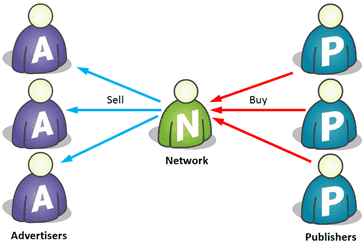
However through this process, what is gained in efficiency is lost in the quality of ads shown to relevant users.
The more advertising networks exist to broker deals between publishers and advertisers in the system, the further advertisers and publishers are separated from each other, which results in more impersonal ads being shown to the wrong people purely for the sake of these middlemen exchanges earning more money.

BAT completely decentralizes these ad networks, enabling publishers and advertisers to deal with each other directly through the BRAVE browsers attention monitoring technology, which increases the quality of ads shown while maintaining efficiency.
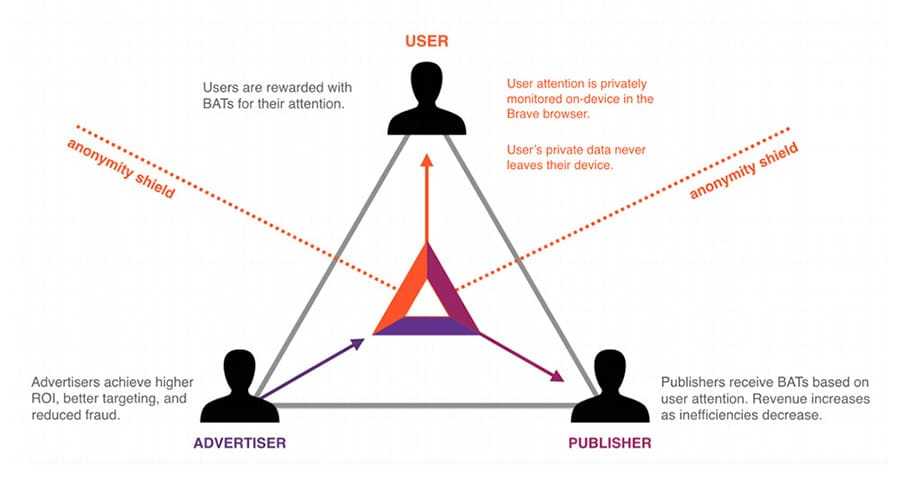
BAT, like most other tokens, can be applied as a utility in the Brave browser platform, or traded for Bitcoin and other coins on public exchanges like Binance.
Brave has plans to provide multiple use cases for users holding BAT tokens. For example, Publishers will be able to offer premium content for those who pay using BAT. Users will also be rewarded with tokens for promoting the publishers content themselves.
Brave Browser V1.0 Released
The Brave browser spent a long time in its beta period, but the first Brave 1.0 production version was finally released on November 13, 2019. This is a turning point for the internet, because this Brave browser is a speed demon, and heavily focused on the privacy of its users. With a cavalier approach to ad-blocking and the promise of BAT payouts, the Brave browser is now on the cusp of an explosion.
With more than 8 million global users already, the Brave 1.0 browser promises users speed, privacy, and improved battery life for their mobile devices.
There are two very clear reasons why Brave is now the leading browser on the market, and neither one has to do with the potential for earning BAT by using the browser.
Here’s what really makes Brave a special browser.
No Tradeoff between Speed & Security
Brave is by far the fastest browser available for any operating system, whether used on a mobile device or a desktop machine. The memory usage of the browser is exceptionally low, and websites load far faster as well. Brave claims loading times are 3-6x faster than other browsers, and I can tell it’s true.
The foundation of Brave’s speed comes from the suite of built-in privacy and security features. You’ve all probably experienced websites loaded with advertisements, trackers, pop-ups, and banners that slow your device to a crawl as it tries to wade through the mountains of extraneous code. And while you can add plugins that block advertisements and trackers on Chrome and Firefox, the Brave browser runs these features by default.

One huge privacy concern recently has been the use of a method known as “fingerprinting” to track user activity all across the internet, which allows advertisers to build a unique and identifiable profile for any tracked user without loading cookies on the computer.
Other browsers have begun to fight back against fingerprinting, and Brave is leading the charge. Besides blocking fingerprinting, the Brave Shield feature also blocks a huge number of invasive advertisements and tracking cookies.
Brave has also sidestepped one common problem found in modern browsers. They can often interfere so greatly with a website to block elements that users are unable to access the content they came to the website for in the first place.
That either means the user has to go elsewhere to find information, or they need to go through the time-consuming and irritating process of disabling security plugins one by one until they can figure out which one is causing the browsing problem.
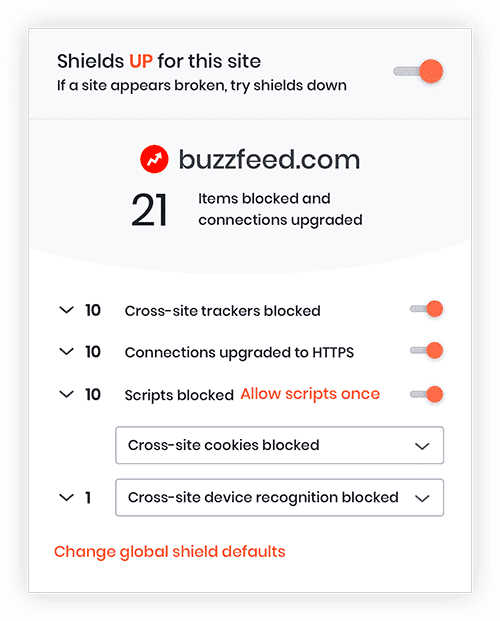
The Brave privacy suite eliminates the need to go through this painful process and makes it faster and far less annoying to have a secure browsing experience. One click on the Brave icon and users are presented with a small menu that has simplified toggles to turn on and off the extensive security features in the browser settings.
Because the Brave browser is built on the Chromium engine that powers Google Chrome it’s possible to increase privacy even further by adding your own choice of extensions in the same way you would when using the Chrome browser. But just because Brave is built with the Chromium engine it doesn’t mean you’re giving up your data to Google.
Brave has stripped the Google-specific code from its version of the Chromium engine, thus not just blocking outside data from getting in, but also blocking data that’s already inside from getting out. The bottom line is you can use Brave without worrying that it’s sharing all your browsing history with Google.
Brave & BAT Power
And here is the feature that attempts to blend user and advertiser needs with privacy concerns and the revenue generated by advertising on websites all across the internet. That feature is Brave Rewards, which users can opt into if they want to support websites with revenue, but still, maintain their privacy.
When opted into Brave Rewards the Brave browser will swap ads on a website with ads of its own. The major difference is the Brave ads don’t track you, and when users view or engage with the ads they get rewarded with BAT tokens.
Brave will keep 30% of the ad revenue spent by advertisers while passing the other 70% on to the Brave users. Users can also utilize the BAT added to their accounts to tip users on a variety of social media and other sites, or by contributing to their favorite websites. For example, Wikipedia is a Brave publisher and can be supported with BAT donations.
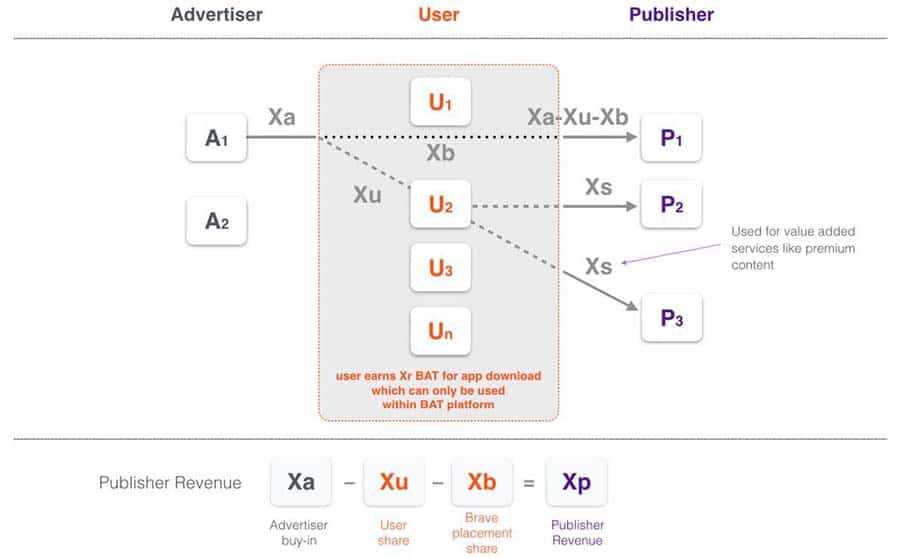
Brave claims the average user can earn roughly $5 per month, with this figure varying based on the region they live in and other factors.
Prior to the release of Brave v1.0 users were unable to withdraw any of the BAT they made using the browser. However it is now possible to withdraw through the cryptocurrency exchange Uphold, and Brave says by next year users will be able to redeem BAT for product discounts, gift cards, and subscriptions, plus more.
Brave has had push-back from advertisers since its inception due to issues with having their content covered. However, when looked at through the eyes of the user trying to avoid the increasing surveillance of corporations, the BAT model is a good one. And considering there are now thousands of advertisers using Brave, even though some are just testing at this point, it seems Brave is here to stay.
The one thing needed now is more users. While 8 million is a good start, it’s a long way from the 250 million users of the Mozilla Firefox browser or the more than 1 billion Google Chrome users.
History and Team
Brendan Eich founded Brave Software in 2017. As the creator of JavaScript and co-founder of Firefox, he’s certainly proven capable of developing large scale and disruptive software when it counts.
In the same year it was founded, the BAT token raised an impressive $35million in just under 30 seconds during their ICO.

Some of the Brave Team Members. Image via Brave.
They have since secured early partners and brought on top talent developers and executives. Other key members of the team include:
- Brian Bondy – Lead Developer, co-founded Brave. Previously: Khan Academy, Mozilla, and Evernote.
- Yan Zhu – Chief Information Security Officer.
- Holli Bohren – Chief Financial Officer.
BAT is headquartered in San Francisco, with an additional office in London. As of December 2019, their workforce has grown to over 100 employees.
Competition
Brave has a few competitors in the Blockchain space disrupting digital advertising.
Papyrus and Adshares both offer similar Blockchain based advertising ecosystems. The main difference is that they focus primarily on publishers and advertisers, leaving users out of the equation.
Braves toughest challenge however will come from the fierce competition it faces in the web and mobile browser space.
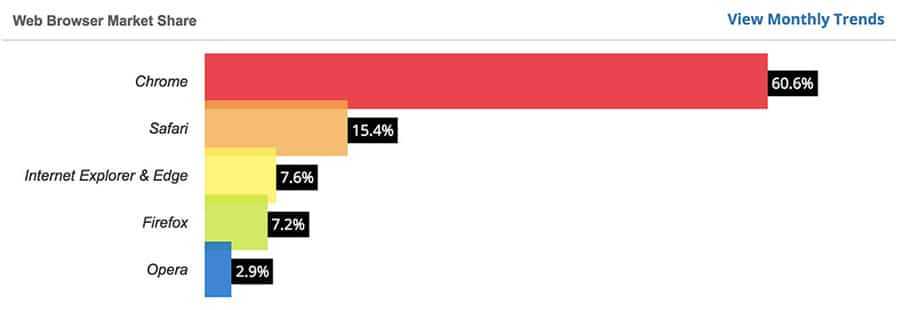
As of March 2018, Google Chrome, Safari, Internet explorer and Firefox collectively made up about 90% of the browser market. Ad blocking capabilities and even an incentive based token ecosystem are features that any of these browsers could replicate if they choose to.
Brave will have to offer much more in order to be considered a viable alternative for everyday users.
BAT Price Performance
The BAT token launched in June 2017 at a price of $0.17. A month later on July 16, 2017 the token hit an all-time low of $0.066209.
It was fortunate timing though as it came just before the great rally in cryptocurrencies at the end of 2017, and BAT hit its all-time high of $0.980702 on January 9, 2018. Of course, from there it dropped throughout 2018 as the entire cryptocurrency space suffered a deep bear market.
2019 saw a recovery early in the year, with BAT reaching $0.44391 by April 21, 2019. Of course, it dropped off those levels but has been holding up fairly well in 2019 compared with many other altcoins.

As of early December 2019, it remains above its launch price and is trading at $0.186301 on December 4, 2019. A week early the BAT token had reached $0.277868 as it rallied following the release of the first production Brave browser.
The chart indicates that BATs price (like most other coins) is moving in accordance with the general wave of market sentiment around crypto-currencies. Like most blockchain projects, I believe it will take some time before the technology is validated enough for the token to start defining its own price trends in the crypto-currency market.
BAT Markets & Storage
When it comes to the markets for BAT, it is quite a popular token and is listed on a number of exchanges including Binance, Coinbase Pro, Bittrex, Huobi etc. However, over 50% of the volume is currently taking place on two of the top exchanges.
This is not one of our preferred exchanges and the fact that the bulk of the trading is taking place here is a potential problem for open market liquidity. It means that these exchanges could have an outsized impact on the market for BAT.

Having said that, the individual liquidity on the order books of exchanges like Binance are pretty deep and liquid. This means that you can execute your orders with relatively little slippage (even for those large block orders).
Once you have your Bat, you’ll need a place to store them safely. The Brave browser uses Uphold to keep your tokens as you earn them for viewing ads, so that’s always an option.
Bat is also an ERC-20 token, so if you already have a wallet that supports this type of token, you can use that. If you don’t, there are plenty to choose from. These include wallets such as MetaMask, MyEtherWallet and hardware wallets such a Trezor / Ledger.
Pros & Cons
Based on this review there are a number of opportunities and challenges that I have identified with the Brave browser. These are just my opinion and I encourage you to do your own research.
First, lets take a look at some of the opportunities we have with Brave & BAT:
- In true Blockchain fashion, BAT aims to displace the middlemen ad exchanges responsible for polluting the ad experience by creating an incentive based decentralized network where publishers, advertisers and users can more effectively feed off of each other’s needs
- The team is highly experienced and has proven to be successful in creating disruptive technologies
- Braves browser provides much faster speeds as a result of its ad blocking features
- Braves privacy browser is already up and working with 10 million monthly users
- The browser monitors user attention in real time, while maintaining anonymity and privacy for users
- The public is increasingly becoming more aware of how ads are negatively impacting their experience. This is shown by the rise in ad blocking software globally (600m devices). At the same time, traditional publishers have lost approximately 66% of their ad revenue over the past decade
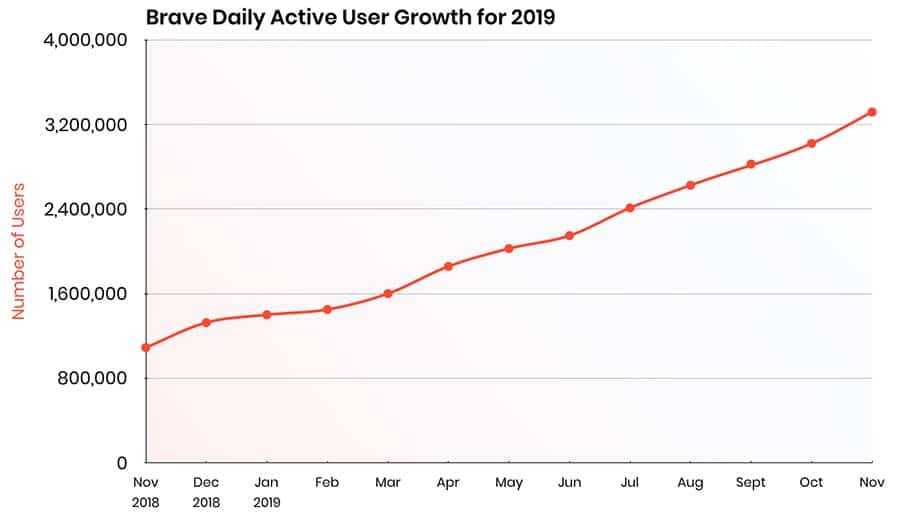
However, there are quite a few disadvantages and challenges that the browser could face coming forward. These include some of the following:
- BAT is relying on people adopting the Brave browser, which could be trouble because of strong competition from Google Chrome, Safari and Brendan’s former company – Firefox. There have been discussions around of Brave developing a Chrome extension to expose their solution to more users, but no release date has been confirmed.
- Advertisers may still face challenges with converting users into paying customers. It seems like the profile of a Brave browser user is someone who:
- Already uses or is interested in using an ad blocker
- Wants a faster browsing experience
- Wants to get paid for viewing ads
- Wants to see more relevant ads
- Wants to save money on mobile data
At this time it’s not so clear which of the 5 traits most accurately describe a Brave user. One would have to assume that having access to an ad blocker would be most important.
However in order for Brave to provide advertisers with a higher ROI, they need to attract users who are willing to pay for products they discover through ads, even though they may only be using the service to earn tokens by viewing these ads.
Generally, people who are interested in viewing ads for money usually aren’t in a position to pay for the products being advertised to them, and in the worst case, may seek to manipulate their views in order to earn more tokens.
This could be a concern for advertisers hoping to attract real customers and increase sales by using Brave.
Conclusion
Brave browser faces stiff competition from the likes of Google Chrome, Safari, Firefox and others. Although they’re currently showing impressive growth with 8 million monthly users, the browser is going to need to form large strategic partnerships that allow for BAT to become integrated into the browsing experience of everyday users across the web.
At the same time, advertisers are going to need assurance that the incentive-based model being proposed will actually help them convert their ad dollars into product sales, and not just guarantee more ad views.
Although Adblockers and a token-based ecosystem are great value propositions, I believe what will ultimately bring Brave and its Basic attention token to mass adoption is the cost savings from reduced data spent on ad downloads and trackers.
The appeal of a browser that can help people cut down 20% of their monthly phone bill is widespread and could be utilized to form partnerships with mobile data providers like Verizon and AT&T.
Ad downloads and trackers currently cost users $23 a month in mobile data. Braves browser cuts down on these costs significantly through its ad blocking technology.
Based on this knowledge, Brave could partner with AT&T, Verizon, and other mobile data providers to reward customers with a discount on unlimited data plans when they adopt the Brave browser on their mobile phone.
From AT&T and Verizon’s perspective, if customers commit to using a low bandwidth browser, data providers can offer them unlimited data at a lower cost to their business.
AT&T and Verizon could benefit from people paying a slightly lower price for their unlimited data plan ($10 or $15 discount for example) because those same consumers might be saving mobile providers $20 or $30 per account by using the Brave browser to cut down their average monthly data usage by 0.5GB.
Ultimately, the value of Braves browser to AT&T and Verizon would be to help them reduce the cost of serving their customers with unlimited data. Such a partnership could allow Brave and BAT access to several million more users.
There’s currently no mention of a mobile data provider partnership occurring, but as a consumer, I’d definitely be excited about the possibility of Verizon charging me $15 less to use their unlimited data plan by simply switching browsers and purchasing BAT.
It’s too early to tell, but I wouldn’t put it past Brendan and his team to explore discounted mobile data plans as the ideal incentive to encourage more mainstream adoption and increased voluntary ad views on the Brave Browser.
Disclaimer: These are writer opinions and should not be considered investment advice. Readers should do their own research.
Disclaimer: These are the writer’s opinions and should not be considered investment advice. Readers should do their own research.
